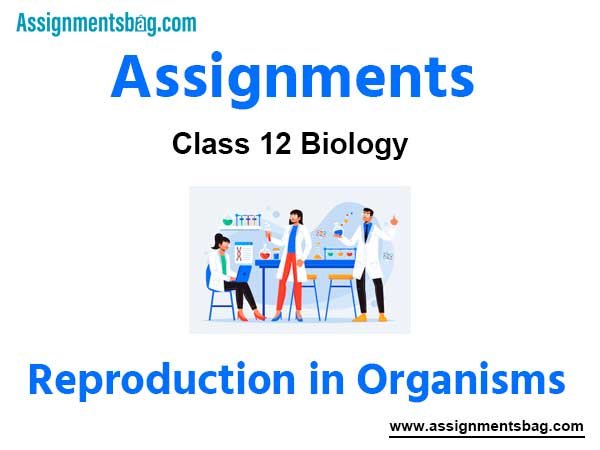Please refer to Assignments Class 12 Biology Reproduction in Organisms Chapter 1 with solved questions and answers. We have provided Class 12 Biology Assignments for all chapters on our website. These problems and solutions for Chapter 1 Reproduction in Organisms Class 12 Biology have been prepared as per the latest syllabus and books issued for the current academic year. Learn these solved important questions to get more marks in your class tests and examinations.
Reproduction in Organisms Assignments Class 12 Biology
Question. Regarding to reproduction which of the following statement is correct :
(a) Asexual reproduction is common among multicellular plants and animals
(b) In monerans cell division itself is a mode of reproduction
(c) During bud formation in yeasts meiotic division occurs
(d) In fungi, fission is most common method of asexual reproduction
Answer
2
Question. Which of the following plant possess non motile male gametes :
(a) Marchantia
(b) Pteridium
(c) Ginkgo
(d) Pisum
Answer
4
Question. What is the duration of juvenile phase in bamboo and interflowering period of Strobilanthus kunthiana respectively :
(a) 50-100 years and 21 years
(b) 50-100 years and 12 years
(c) 25-300 years and 12 years
(d) 25-30 years and 21 years
Answer
2
Question. Find out the incorrect statement :
(a) Cucurbits are monoecious plants
(b) Papaya is a dioecious plant
(c) Meiocytes are haploid
(d) Male gametes are transfered through pollen tube in spermatophytes
Answer
3
Question. Which of the following is not a distinct stage of sexual reproduction :
(a) Pre gametogenesis stage
(b) Pre fertilisation stage
(c) Fertilisation stage
(d) Post fertilisation stage
Answer
1
Question. First cell of sporophytic generation is :
(a) Gamete
(b) Spore
(c) Zygote
(d) Embryo
Answer
3
Question. Match the following regarding to number of chromosomes in meiocyte :
| (A) Ophioglossum | (i) 20 |
| (B) Apple | (ii) 24 |
| (C) Rice | (iii) 34 |
| (D) Maize | (iv) 1260 |
(a) A(iv), B(iii), C(i), D(ii)
(b) A(iv), B(i), C(ii), D(iii)
(c) A(iv), B(ii), C(iii), D(i)
(d) A(iv), B(iii), C(ii), D(i)
Answer
4
Question. Which of the following is a dioecious plant :
(a) Datepalm
(b) Cucumber
(c) Maize
(d) Chara
Answer
1
Question. “Water hyacinth” or Eichhornia is one of the important problematic weed of static water in India. Which of the following statement is incorrect about it :
(a) It is also known as “Terror of Bengal”
(b) It is native plant of India
(c) It increases biological oxygen demand of waterbody
(d) It spreads rapidly through vegetative reproduction
Answer
2
Question. From the formation of embryo point of view, which of the following plant group is the odd one :
(a) Algae
(b) Bryophytes
(c) Pteridophytes
(d) Gymnosperms
Answer
1
Question. Sexual reproduction is of isogamous type in :-
(a) Riccia
(b) Selaginella
(c) Cladophora
(d) Cycas
Answer
3
Question. Which of the following structure is the vital link that ensures continuity of species between organisms of one generation and the next :
(a) Endosperm
(b) Zygote
(c) Embryo
(d) Sex organs
Answer
2
Question. Find out incorrect statement :
(a) Period from birth to natural death called life span
(b) Life span of organisms are necessarily correlated with their size
(c) Except single celled organisms, all others are mortal
(d) Reproduction enables the continuity of species, generation after generation
Answer
2
Question. During embryogenesis zygote go through which of the following process/processes :
(a) Cell division
(b) Cell differentiation
(c) Both 1 and 2
(d) Either cell division or cell differentiation
Answer
3
Question. Interaction of which of the following factors regulate the reproductive processes and the associated behavioral expression of organisms :
(a) Only hormones
(b) Only environmental factors
(c) Both (1) and (2)
(d) Photosynthetic efficiency
Answer
3
Question. Match the following (with respect to life span) : (Image)

(a) A(II), B(III), C(IV), D(I)
(b) A(III), B(II), C(IV), D(I)
(c) A(II), B(III), C(I), D(IV)
(d) A(III), B(IV), C(II), D(I)
Answer
1
Question. Cultivation of floral plants is known as
(a) Horticulture
(b) Floriculture
(c) Sericulture
(d) Vermiculture
Answer
2
Question. Where does syngamy occur in algae?
(a) In archegonium
(b) In water or oogonium
(c) In Ovary
(d) In the soil
Answer
2
Question. Which ot the following has the longest life span ?
(a) Butterfly
(b) Crocodile
(c) Parrot
(d) Tortoise
Answer
D
Question. A clone is a group of individuals obtained through
(a) self-pollination
(b) hybridization
(c) asexual reproduction
(d) cross-pollination
Answer
C
Question. Asexual reproduction is common among
(a) single celled organisms only.
(b) plants only.
(c) animals with simple organization.
(d) single celled animals, plants and animals with simple organizations.
Answer
D
Question. In yeast cell division results in a small cell called
(a) bud
(b) clone
(c) branch
(d) offspring
Answer
A
Question. The term ‘Terror of Bengal’ is used for
(a) Bengal tiger
(b) water hyacinth
(c) algal bloom
(d) aquatic fauna
Answer
B
Question. In sexual reproduction, offsprings resemble the parents
(a) structurally but not functionally.
(b) functionally but not structurally.
(c) both structurally and functionally.
(d) neither structurally nor functionally.
Answer
B
Question. The end of vegetative phase in plants which marks the beginning of the reproductive phase can be easily seen in the higher plants when they come to
(a) flower
(b) fertilize
(c) pollinate
(d) None of the above
Answer
A
Question. In flowering plants both male and female gametes are non-motile. The method to bring them together for fertilization is
(a) water
(b) air
(c) pollination
(d) apomixis
Answer
C
Question. Syngamy means
(a) fusion of similar spores.
(b) fusion of gametes.
(c) fusion of dissimilar spores.
(d) fusion of cytoplasm.
Answer
B
Question. Which of the followings is a post-fertilization event in flowering plants ?
(a) Transfer of pollen grains
(b) Embryo development
(c) Formation of flower
(d) Formation of pollen grains
Answer
B
Statement Type Questions for Class 12 Biology Reproduction in Organisms
Question. Which of the following statement about animal reproduction is incorrect ?
(a) Species that reproduce sexually cannot reproduceasexually.
(b) Viviparity, but not ovoviviparity, is common in mammals.
(c) Male insects can remove spermatophores deposited in a female by other males.
(d) Oogenesis and spermatogenesis both occur simultaneous in hermaphrodites.
Answer
A
Question. Which of the following statement is correct in the process of fertilization ?
(a) Only one sperm reaches the egg and enters it.
(b) The entry of sperm activates the egg for completing meiosis.
(c) Two haploid nuclei fuse and immediately divide to produce two nuclei which are again haploid.
(d) Only the acrosome of the sperm enters the egg.
Answer
B
Question. Select the incorrect statement.
(a) Anisogametes differ either in structure, function or behaviour.
(b) In oomycetes, female gamete is smaller and motile, while male gamete is larger and non-motile.
(c) Chlamydomonas exhibits both isogamy and anisogamy and Fucus shows oogamy.
(d) Isogametes are similar in structure, function and behaviour.
Answer
B
Question. Which of the following statements is/are correct ?
(i) The genetic constitution of a plant is unaffected in vegetative propagation.
(ii) Rhizome in ginger serves as an organ of vegetative reproduction.
(iii) Totipotency of cells enables us to micropropagate plants.
(a) (i) and (ii)
(b) (ii) and (iii)
(c) (ii) only
(d) All of these
Answer
D
Question. Which of the following statements is incorrect ?
(i) Bamboo species flower only once in their life time, generally after 50-100 years and produce large number of fruits and die.
(ii) In animals, the juvenile phase is followed by morphological and physiological changes prior to active reproductive behaviour.
(iii) The reproductive phase is of same duration in all organisms.
(iv) Juvenile phase is the period of growth between the birth of an individual till it reaches reproductive maturity.
(a) Only (i)
(b) Only (ii)
(c) Only (iii)
(d) Only (iv)
Answer
C
Question. Which one of the following option is correct regarding the given statements ?
(i) The plant was introduced in India because of its beautiful flowers and shape of leaves.
(ii) It can propagate vegetatively at a phenomenal rate and spread all over water body in a short period.
(iii) It is very difficult to get rid off these plants.
(iv) It is associated with flowering plants.
(a) Dahlia
(b) Water hyacinth
(c) Azolla (water fern)
(d) Mosses
Answer
B
Question. Read the following statements regarding sexual reproduction and selects the incorrect ones.
(i) Sexual reproduction does not always require two individuals.
(ii) Sexual reproduction generally involves gametic fusion.
(iii) Meiosis never occurs during sexual reproduction.
(iv) External fertilization is a rule during sexual reproduction.
(a) (i) and (iii) (b) (iii) and (iv)
(c) (i), (ii) and (iii) (d) (ii), (iii) and (iv)
Answer
B
Question. Which of the following statements regarding the asexual reproduction is incorrect?
(a) Both mitotic and meiotic division occurs.
(b) It does not contribute to evolution and speciation.
(c) It is uniparental and usually occurs in unicellular organisms.
(d) There is no variation and the offsprings have the same phenotype and genotype.
Answer
A
Assertion/Reason Type Questions for Class 12 Biology Reproduction in Organisms
In the following questions, a statement of Assertion is followed by a statement of Reason.
(a) If both Assertion and Reason are true and the Reason is the correct explanation of the Assertion.
(b) If both Assertion and Reason are true but the Reason is not the correct explanation of the Assertion.
(c) If Assertion is true but Reason is false.
(d) If both Assertion and Reason are false.
Question. Assertion: Zygote is the link between two generations.
Reason: Zygote is the product of two gametes and producer of next generation.
Answer
A
Question. Assertion: Ants, bees and termite show parthenogenesis.
Reason: Parthenogenesis is the process in which new organism is formed without fertilization.
Answer
A
Matching Type Questions for Class 12 Biology Reproduction in Organisms
Question. Match column-I with column-II and select the correct answer using the codes given below.
| Column-I | Column-II |
| A. Animals which give | I. Hydra birth to young one |
| B. Animal which produces | II. Planaria bud |
| C. An animal which | III. Viviparous shows regeneration |
| D. Provides nutrition | IV. Placenta to the developing embryo from the mother |
(a) A – I; B – III; C – II; D – IV
(b) A – III; B – I; C – II; D – IV
(c) A – III; B – I; C – IV; D – II
(d) A – III; B – IV; C – I; D – II
Answer
B
Question. Match column-I with column-II and select the correct option.
| Column -I (Name of the organism) | Column- II (Haploid chromosome number in gamete) |
| A. Ophioglossum (fern) | I. 23 |
| B. Rice | II. 24 |
| C. Potato | III. 12 |
| D. Man | IV. 630 |
(a) A – I; B – II; C – III; D – IV
(b) A – II; B – III; C – IV; D – I
(c) A – III; B – IV; C – II; D – I
(d) A – IV; B – III; C – II; D – I
Answer
D
Question. Match the name of the organism given in column I with their chromosome number in meiocytes choose the correct combination from the options given below.
| Column-I (Name of the organism) | Column-II (Chromosome number in meiocyte) (2n) |
| A. House fly | I. 20 |
| B. Fruit fly | II. 34 |
| C. Apple | III. 8 |
| D. Maize | IV. 12 |
(a) A – II; B – III; C – IV; D – I
(b) A – III; B – IV; C – II; D – I
(c) A – IV; B – III; C – I; D – II
(d) A – IV; B – III; C – II; D – I
Answer
D
Question. Match the definition (given in column I) with their correct term (given in column II) and choose the correct combination from the options given.
| Column-I | Column-II |
| A. The pollen transferred | I. Germination from one flower to another |
| B. The process in which | II. Pollination embryo develops into seedling |
| C. Fertilized egg in humans | III. Menstruation gets implanted in |
| D. When egg in humans | IV. Uterus is not fertilized process occur |
(a) A – II; B – I; C – IV; D – III
(b) A – I; B – II; C – IV; D – III
(c) A – I; B – II; C – III; D – IV
(d) A – I; B – III; C – II; D – IV
Answer
A
Question. Find out the incorrectly matched pair.
(a) Tuber – Potato
(b) Rhizome – Ginger
(c) Bulbil – Agave
(d) Leaf buds – Banana
Answer
D
Diagram Type Questions for Class 12 Biology Reproduction in Organisms
Question. The given figures show the members of fungi and simple plants such as algae which undergo asexual reproduction.
Identify the correct asexual reproductive structures found in the members A, B, C and D.
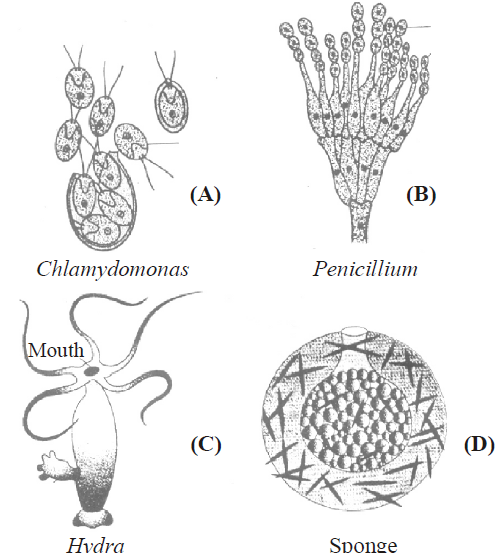
(a) A-Zoogamete, B-Conidia, C-Bud, D-Gemmule
(b) A-Zoospore, B-Conidia, C-Bud, D-Gemmule
(c) A-Zoospore, B-Conidiosporangium, C-Bud, D-Gemmule
(d) A-Aplanospore, B-Conidia, C-Bud, D-Gemmule
Answer
B
Question. The given figure represents the events marked as (A, B, C and D) in the life of general reproduction. Identify the events A, B, C and D.
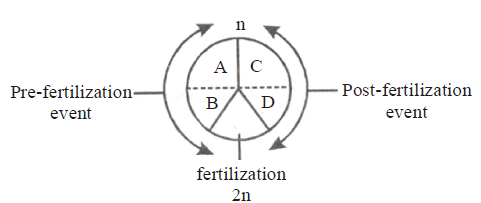
(a) A-Gamete transfer, B-Gametogenesis, C-Zygote formation, D-Embryogenesis
(b) A-Gametogenesis, B-Gamete transfer, C-Zygote formation, D-Embryogenesis
(c) A-Gametogenesis, B-Zygote formation, C-Gamete transfer, D-Embryogenesis
(d) A-Gametogenesis, B-Gamete transfer, CEmbryogenesis, D-Zygote formation.
Answer
B
Question. The given figures (A, B and C) are types of gametes of different organisms. Identify gametes (A, B and C) respectively.
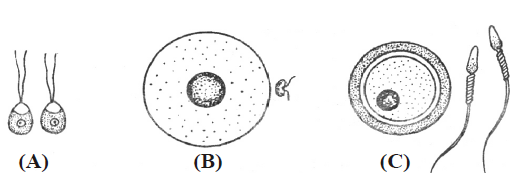
(a) Heterogametes, Isogametes, Homogametes
(b) Isogametes, Homogametes, Heterogametes
(c) Homogametes, Isogametes, Heterogametes
(d) Homo/Isogametes, Heterogametes, Heterogametes
Answer
B
Question. Which of the labelled parts (X and Y) in the transverse section of pea plant is/are diploid ?
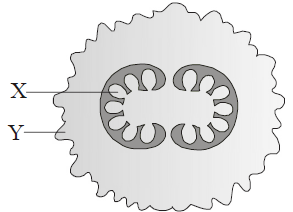
(a) X
(b) Y
(c) Both X and Y
(d) None of these
Answer
C
Question. In the given figure of water hyacinth, a structure is marked as “X”. This structure is involved in vegetative propagation as a unit of vegetative propagules. Identify the type of unit.
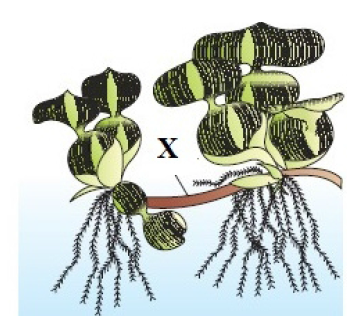
(a) Tuber
(b) Offsets
(c) Sucker
(d) Rhizome
Answer
B
Critical Thinking Diagram Type Questions for Class 12 Biology Reproduction in Organisms
Question. If soil around stem of potato plant is constantly removed from very young stage then only roots remain in the soil then the potato tubers in plant will
(a) be larger
(b) be smaller
(c) be formed normally
(d) not be formed
Answer
D
Question. Which is the most common method of reproduction in majority of fungi and bacteria ?
(a) Binary fission
(b) Multiple fission
(c) Budding
(d) Spore formation
Answer
D
Question. Sexual reproduction involves
(a) meiosis only.
(b) meiosis and fusion of gametes.
(c) both mitosis and meiosis.
(d) all of the above
Answer
B
Question. Seeds are regarded to be the product of sexual reproduction because they
(a) can be stored for a long period.
(b) give rise to new plants.
(c) are the result of fusion of male gamete with the female gamete.
(d) none of the above
Answer
C
Question. “X” is the vital link that ensures continuity of species between organisms of one generation to the next. Every sexually reproducing organism begins life as a single cell “X”. Identify “X”.
(a) Zygote
(b) Gamete
(c) Embryo
(d) None of the above
Answer
A
Question. Development of zygote depends on
(a) life cycle of the organism
(b) environment it is exposed to
(c) both (a) and (b
(d) nutrition of organism
Answer
C
Question. In a practical test, a student has to identify the organisms in which syngamy does not occur. In those organisms the female gamete undergoes development to form new organisms without fertilization. This phenomenon is called “X”.
Identify the organisms and the phenomenon “X”.
(a) Frog, Parthenogenesis
(b) Lizards, Gametogenesis
(c) Rotifers, Embryogenesis
(d) Honeybee, Parthenogenesis
Answer
D
Question. Offsprings of oviparous animals are at greater risk as compared to offsprings of viviparous animals because
(a) proper embryonic care and protection is lesser.
(b) embryo is not developed.
(c) progenies are with more variation.
(d) progenies are larger.
Answer
A
